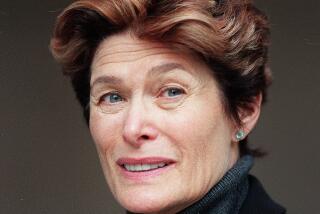Herbert Nipson dies at 95; helped broaden Ebony magazine’s audience
When Herbert Nipson joined Ebony magazine’s editorial staff in 1949, the publication, founded just four years earlier in Chicago, had a target readership of urban African Americans, and its stories reflected that sensibility.
But as the civil rights movement surged to the forefront of American consciousness, Nipson helped push the magazine to a broader audience, covering issues important to rural African Americans and branching out into sports, entertainment and the arts.
By the time he retired in 1987, after 15 years as executive editor, the magazine enjoyed national recognition and mainstream appeal for both its issue-oriented reporting and its cultural coverage.
Linda Johnson Rice, chairwoman of Ebony’s parent company, Johnson Publishing, which was founded by her late father, John H. Johnson, recalled Nipson’s contributions to the magazine.
“ ‘Nip,’ as we all knew him, was an extraordinary presence for as long as I can remember going to the Johnson Publishing Co. offices.,” she said. “He was a guiding force in shaping Ebony. His vision was essential to making the magazine what it is today.”
Nipson, 95, died of natural causes Dec. 10 at his home in Albuquerque, N.M.
An avid art collector who in his younger years dreamed of being a photojournalist, Nipson served for many years as president of the board of the South Side Community Arts Center in Chicago, the first black art museum in the United States when it opened in 1940.
“He was like a big brother figure to me when I was a struggling art student at the arts center,” said close friend Douglas R. Williams, an artist-in-residence at the center. “Herb would advise me, he’d critique my work, he’d even buy me groceries.
“In the creative world, we call those people angels.”
Born July 26, 1916, in Asheville, N.C., Nipson grew up in Clearfield, Pa. He graduated in 1940 from Pennsylvania State University, where he majored in journalism. In 1939 he became the first black student elected to Sigma Delta Chi, the national journalism honor society, according to Penn State’s website chronicling African American history at the university.
“He found out later that the only reason he was accepted was because the application for his nomination failed to note his race,” said his daughter, Maria Nipson.
During World War II, Nipson served in the Army as a driving instructor. When the war ended, he enrolled at the University of Iowa, where he received his master’s in creative writing in 1948.
The following year, Nipson joined Ebony as an associate editor who occasionally wrote celebrity profiles, including one on singer Nat King Cole in the early 1950s.
In 1972, Nipson was promoted to executive editor. He retired after 38 years and 456 issues of Ebony in 1987.
Nipson’s wife of 60 years, Velvin, died in 2002. After her death, he spent part of the year in Albuquerque, where he lived in a house behind his daughter’s home, and his summers in Cambridge, Mass., where he stayed with his son, Herbert, and his family.
Other survivors include two sisters and two grandchildren.
More to Read
The biggest entertainment stories
Get our big stories about Hollywood, film, television, music, arts, culture and more right in your inbox as soon as they publish.
You may occasionally receive promotional content from the Los Angeles Times.




















































